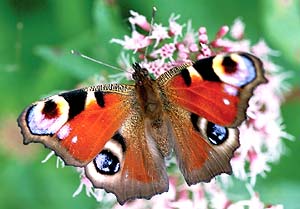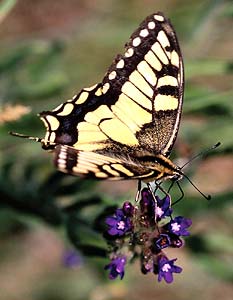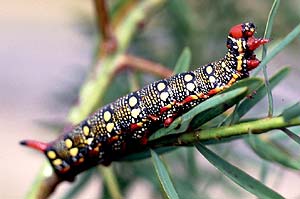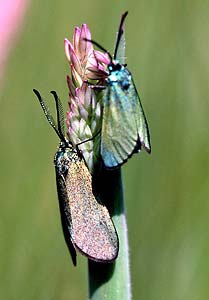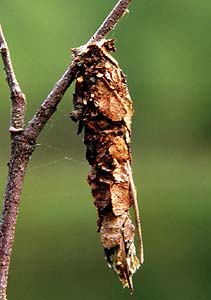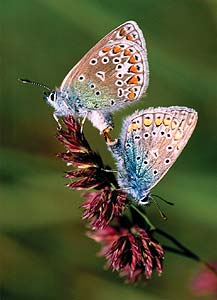|
TERRESTRIAL INSECTS
|
|||||||||||||||
Text:
|
Butterflies and moths
About 150 000 lepidopteran species have so far been described on our planet, and more than 3 000 of them occur in Poland. Around 220 species have been discovered in the Wigry National Park.
Lepidopterans are usually divided into two groups: the smaller Microlepidoptera and the larger Macrolepidoptera, the latter including diurnal butterflies and nocturnal moths. The occurrence of a species in an environment depends mainly on the availability of plants serving as food for its caterpillars.
An adult lepidopteran has two pairs of wings, which are covered with scales which produce a colourful pattern. In certain species, however, the wings of females are greatly reduced making them unable to fly. The mouth apparatus of butterflies and moths involves a long tubular proboscis, which is coiled at rest and unwound for feeding through sucking up food such as flower nectar, sap and fruit juice.
Butterflies and moths undergo a complete metamorphosis. Their eggs are characterised by a great variety of colours and shapes. Females deposit their eggs directly on or somewhere close to host plants. The larvae hatch after a certain time, from a few days up to several months. The following period of intense feeding is accompanied by repeated shedding of the cuticular layer, which is inflexible and has to be replaced during the growth phase. The growing larvae cast off the old cuticle and develop a new larger one. The lepidopteran caterpillars are usually as gorgeously coloured as their adult forms. The larval period ends with the pupal stage. The wings of an adult insect that has just left the cocoon are shrivelled and flabby. They reach the right size and shape once they are filled with haemolymph.
Due to their relatively low activity, some of the easiest creatures to observe are burnets (Zygaenidae). They are characterized by magnificent, often contrasting, wing pigmentation. Burnet caterpillars deter their potential enemies by releasing a thick, stinking liquid.
Some of the most interesting lepidopterans are sweeps (Psychidae) whose females have strongly reduced wings and live in little cases, which they build during the larval stage. The cases of sweeps resemble the cases of some caddis flies.
One of our largest moths is the goat moth (Cossus cossus). Its caterpillar grows up to 10 cm in length and the wingspan of an adult insect reaches 9.5 cm. Among the smallest lepidopterans are the leaf rollers (Tortricidae) whose larvae can roll leaves in a specific way.
One of our most common butterflies is the swallowtail (Papilio machaon), which was a protected species until recently. Nowadays its population is large enough for the protection to be withdrawn. Brightly pigmented green and black swallowtail caterpillars, recognizable by little red dots, feed on umbellifers and are commonly found in the garden, especially on carrot and dill plants.
The blues (Lycaenidae) are characterized by remarkable features of their biology. Their caterpillars produce a sweet juice that is favoured by ants. That is why the former are often visited by ants, with some blues species even nurtured in anthills in exchange for their sweet product.
The commonly met brush-footed butterflies (Nymphalidae) are large, colourful diurnal insects. They are mostly represented by the peacock butterfly (Inachis io) whose black caterpillars feed on nettle and hop, as well as the small tortoiseshell (Aglais urticae) that can be seen around the Park from early spring till late autumn. Forest roads and clearings are places where we can find the lesser purple emperor (Apatura ilia). This insect alights on injured tree trunks to drink the sap, as well as on puddle edges and dung.
Some of the most remarkable lepidopterans are the hawk moths (Sphingidae). They have a thick and heavy abdomen, a hair-covered body and an exceptionally long proboscis. Some species, like the humming-bird hawks, resemble humming-birds as they remain suspended over flowers and drink their nectar while hovering.
|
||||||||||||||
|
|
|
